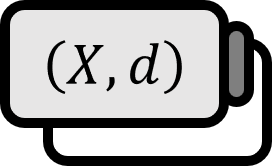Heine-Borel Theorem
Theorem
Definition
A set $\mathcal{O} = \left\{ ( x , y ) \ | \ x < y \right\}$ of open intervals that satisfies $\displaystyle E \subset \bigcup_{\alpha \in \forall} ( x_{\alpha} , y_{\alpha})$ for a subset $E \subset \mathbb{R}$ of real numbers is called an open covering of $E$. That $E$ is compact means for every open covering $\mathcal{O}$ of $E$, there exists a finite subset $\left\{ O_{1} , O_{2} , \cdots , O_{m} \right\}$ of $\mathcal{O}$ that satisfies $\displaystyle E \subset \bigcup_{i =1}^{m} O_{i}$.
Heine-Borel
The necessary and sufficient condition for $E \in \mathbb{R}$ to be compact is that $E$ is bounded and a closed set.
Description
Simply put, the closed interval $[a,b]$ is evidently compact. Another equivalent condition is that “every infinite subset of $E$ has an accumulation point $p\in E$”, though knowing the aforementioned condition should suffice at least in the Euclidean space $\mathbb{R}$.
Proof 1
$(\Longrightarrow)$
Since $E$ is compact, there exists a natural number $N$ that satisfies
$$ E \subset \bigcup_{k =1}^{N} (r - k , r + k) $$
for some real number $r$, and hence $E$ is bounded. Moreover, one can be assured that $E \ne \emptyset$ since the empty set does not meet the condition of boundedness. Assuming $E$ is an open set for contradiction,
If $E$ were a finite set, a union of single-element sets would trivially be a closed set, so we assume that $E$ is infinite. Then there must exist at least one accumulation point $\displaystyle \lim_{k \to \infty} x_{k} = x$ not included in $E$. Letting $d_{i} := |x- y_{i}| / 2$ for a point $y_{i} \in E$ inside $E$, it follows that $d_{i} > 0$ since $x \notin E$. Thus for every $y_{i} \in E$, the interval $\left( y_{i} - d_{i} , y_{i} + d_{i} \right)$, being an open set and including $y_{i}$, $$ \left\{ \left( y_{i} - d_{i} , y_{i} + d_{i} \right) : y_{i} \in E \right\} $$ becomes one of the open coverings of $E$. Since $E$ is compact, $$ E \subset \bigcup_{i =1}^{M} \left( y_{i} - d_{i} , y_{i} + d_{i} \right) $$ there exists a natural number $M \in \mathbb{N}$ that satisfies, and therefore a finite number of $d_{i}$ exists, the minimum of which $$ d_{0} : = \min \left\{ d_{1} , d_{2} , \cdots , d_{M} \right\} $$ also exists. Meanwhile, given that $\displaystyle \lim_{k \to \infty} x_{k} = x$, there exists a $x_{k} \in E$ for sufficiently large $k$ such that $\left| x - x_{k} \right| < d_{0}$, where $x_{k}$ belonging to $E$ implies it is also in some $\left( y_{i} - d_{i} , y_{i} + d_{i} \right)$, meaning $$ x_{k} \in \left( y_{i} - d_{i} , y_{i} + d_{i} \right) $$ is true for some $i \in \left\{ 1 , \cdots , M \right\}$. Therefore, some $i \in \left\{ 1 , \cdots , M \right\}$ exists that ensures $\left| y_{i} - x_{k} \right| < d_{i}$.
However, following the selection of $d_{i}$ and $d_{0}$, the development below must hold by the triangle inequality. $$ \begin{align*} d_{i} > & |x_{k} - y_{i}| \\ \ge & |x - y_{i}| - |x - x_{k} | \\ = & 2 d_{i} - |x - x_{k}| \\ > & 2 d_{i} - d_{0} \\ \ge & 2 d_{i} - d_{i} \\ = & d_{i} \end{align*} $$ Summing up, $d_{i} > d_{i}$ leads to a contradiction, and $E$ is closed.
$(\Longleftarrow)$
Consider a set $E := [a,b]$ that is bounded and closed. For the closed interval $[a,b]$, let $\displaystyle \left[a , {{a+b} \over {2}} \right]$ be the left half and $\displaystyle \left[{{a+b} \over {2}} , b \right]$ the right half. Assuming for contradiction that the closed interval $[a,b]$ is not contained in any finite union of elements $\displaystyle \bigcup_{i =1}^{m} O_{i}$ of some $\mathcal{O}$.
If both $\displaystyle \left[a , {{a+b} \over {2}} \right]$ and $\displaystyle \left[{{a+b} \over {2}} , b \right]$ are contained in some $\displaystyle \bigcup_{i \in I } O_{i}$, it can be represented by $\displaystyle [a,b] \subset \bigcup_{i =1}^{m} O_{i}$, meaning either the left or right half of $[a,b]$ must not be contained in any $\displaystyle \bigcup_{i \in I } O_{i}$. Let the not-contained half be $[a_{1} , b_{1}]$.This process can be repeated for $[a_{n+1}, b_{n+1}] \subset [a_{n} , b_{n}]$, and since $\displaystyle b_{n} - a_{n} = {{1} \over {2^n}} (b-a)$,
$$ \displaystyle \lim_{ n \to \infty } ( b_{n} - a_{n} ) = 0 $$
Cantor’s Nested Interval Theorem: For nested intervals $[a_{n}, b_{n}]$, if $\displaystyle \lim_{n \to \infty} (b_{n} - a_{n}) = 0$ then $\displaystyle \bigcap_{n=1}^{\infty} [a_{n}, b_{n}]$ is a singleton.
By Cantor’s Nested Interval Theorem, $\displaystyle \bigcap_{n=1}^{\infty} [a_{n}, b_{n}]$ contains exactly one element $p$, thus $p \in [a,b]$ must be true. Hence, for a very small positive number $\varepsilon >0$,
$$ ( p - \varepsilon , p + \varepsilon) \subset O $$
a $O \in \mathcal{O}$ that satisfies will exist. If we take a natural number $n_{0}$ such that
$$ p \in [a_{n_{0}},b_{n_{0}},] \subset (p - \varepsilon , p + \varepsilon ) \subset O $$
Originally, $[a_{n_{0}},b_{n_{0}}]$ was chosen not to be contained in any union of $O_{i}$, yet it ended up being included in $O$. Therefore, $\displaystyle [a,b] \subset \bigcup_{i =1}^{m} O_{i}$ must hold.
■
Heine-Borel Theorem in Euclidean Spaces
The necessary and sufficient condition for $E$ to be compact in $E \subset \mathbb{C}^{n}$ is that $E$ is bounded and a closed set.
Meanwhile, this theorem also applies to $E \subset \mathbb{C}^{n}$.
Wade. (2013). An Introduction to Analysis(4th Edition): p309~310. ↩︎
